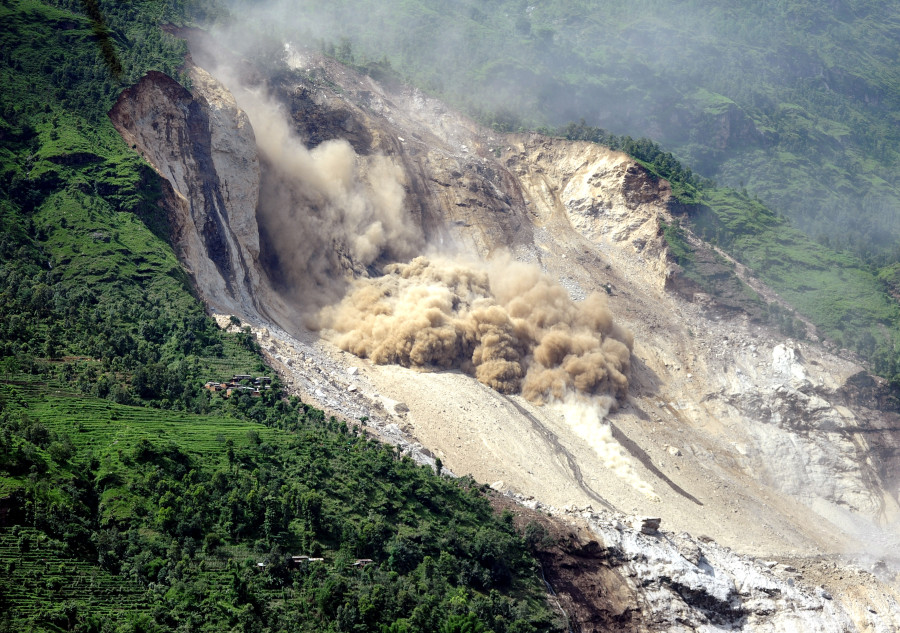3 WORST GEOHAZARD IN NEPAL AND PREVENTIVE MEASURES

Nepal is a small country with an area of 147,516 km2 which lies in southeast Asia. It’s rich in topography as it ranges from( 60m-8848m) Terai region to the Himalayan region. This topographical diversity enhances the beauty of Nepal which makes it possible to call as a country full of Geological wonders which includes deep gorge, high hills, mountains, rivers, streams, Glaciers, and many more. Being a country full of Marvellous features there arises some possible Geohazard in Nepal that may be life-threatening and cause deformation and destruction of landforms.
Geohazards are the geological phenomena or processes that may cause loss of life, damage of property, environmental degradation, and socio-economic losses. Geohazard in Nepal includes some of the internal earth processes like an earthquake, volcanic activity, and other geophysical processes like a landslide, flood, debris, and mudflow.
Some major Geohazard in Nepal are
1. Landslide

source-Kathmandu post
Landslide is the downward movement of the land slope which causes massive deformation in the structure of the land. Landslide causes a devastating impact on both livelihood and economic. In the context of Nepal, being a mountainous country it consists of various high hills and peaks. These peaks and high hills are made up of weak sedimentary to strong metamorphic rock. Landslide is most active in hills having weak rocks and is triggered by monsoon and earthquake. Landslide occurs frequently in our country which leads to various impacts on livelihood.
Preventive Measures

- The afforestation Campaign should be started in the barren slope.
- A proper surface water drainage system should be equipped.
- Construction of Gabion wall and retaining wall in the landslide-prone area.
- Slope and high hills consist of many cracks, so these cracks should be filled before it widens and leads to a landslide.
- People living in highly landslide affected areas should consult with the government and should be shifted from that place as quickly as possible.
2. Flood

Flood is the overflow of water in the river, streams which are caused by heavy rainfalls. Flood is an active geohazard in Nepal which becomes more active during the monsoon period. Flood results in numerous loss of lives and destruction of structures and buildings. Terai region of Nepal is under a high risk of Flood as compared to other regions. On a major note, Urban flooding is becoming a serious problem in our country. Urban areas like Bhaktapur, Kapan faces a problem of flood during high rainfall due to lack of proper drainage and sewage disposal.
Preventive measures-
- People living in Flood affected areas should construct their houses far from river areas.
- Vegetation plantations like small trees, shrubs, and grasses in the river banks.
- Construction of Dykes and spurs to control riverbank erosion.
- Proper sewage disposal and drainage facilities should be constructed in urban areas to prevent flooding.
- During the flood, people should be evacuated to high ground as far as possible.
3.Earthquake

An earthquake is a sudden shaking and vibration on the surface of the earth’s crust, which is caused by a sudden release of energy in the form of seismic waves. Nepal is prone to earthquakes, as it lies in between two plate boundaries i.e the Eurasian plate and Indian plate boundaries. The collision between these plates results in the release of massive energy and orogeny processes*(Orogeny process is a mountain building process). Nepal has suffered from a massive 7.8 magnitude earthquake in 2072 BS, which was a complete disaster. Since 2072 BS, Nepal has encountered numerous earthquakes. Earthquake triggers various other geohazards like Landslide, Floods, Tsunami, Subsidence.
Preventive Measures
- Construction of Earthquake proof Houses.
- During an Earthquake, try to get to an open area, if you are stuck at home try to get away from objects that will fall or break, take shelter under furniture.
- Try to know your surroundings and environment, as for us we live in an earthquake-prone country, so it’s better to prepare a bag containing all the first aid and medicines, flashlight, water, and all necessary stuff.
Related Topic: Altitude Sickness: Symptoms, Treatment & Medication


